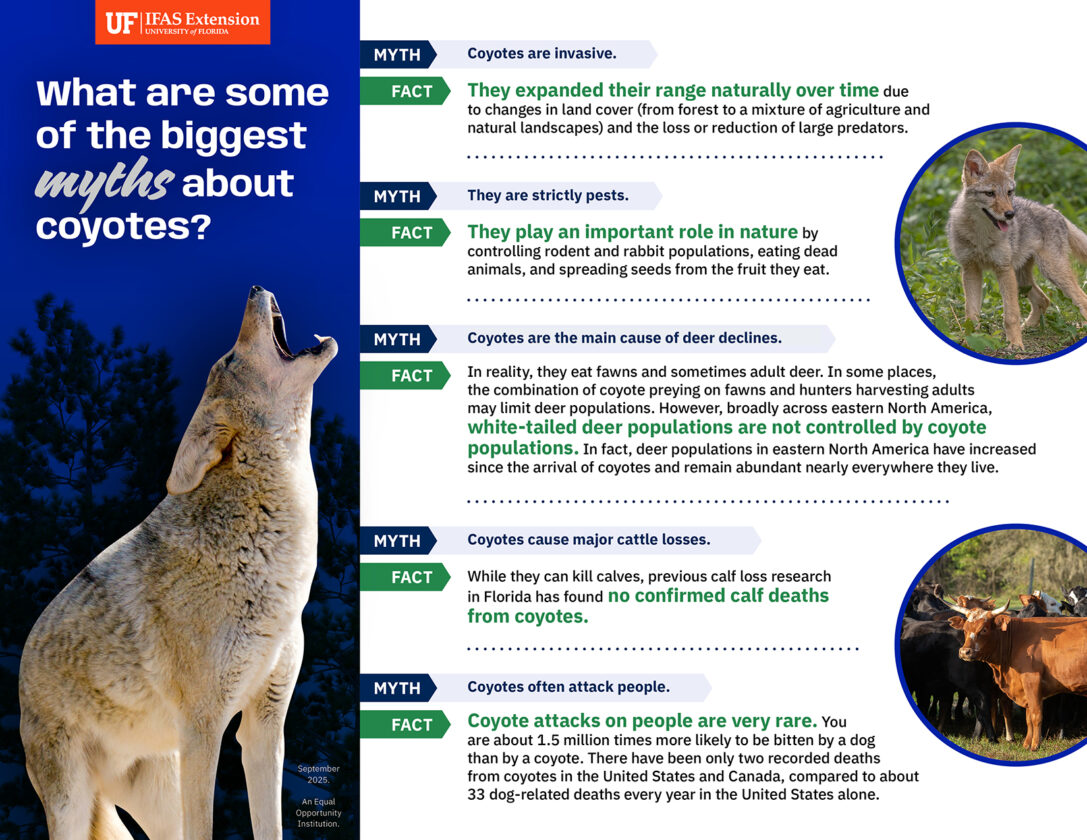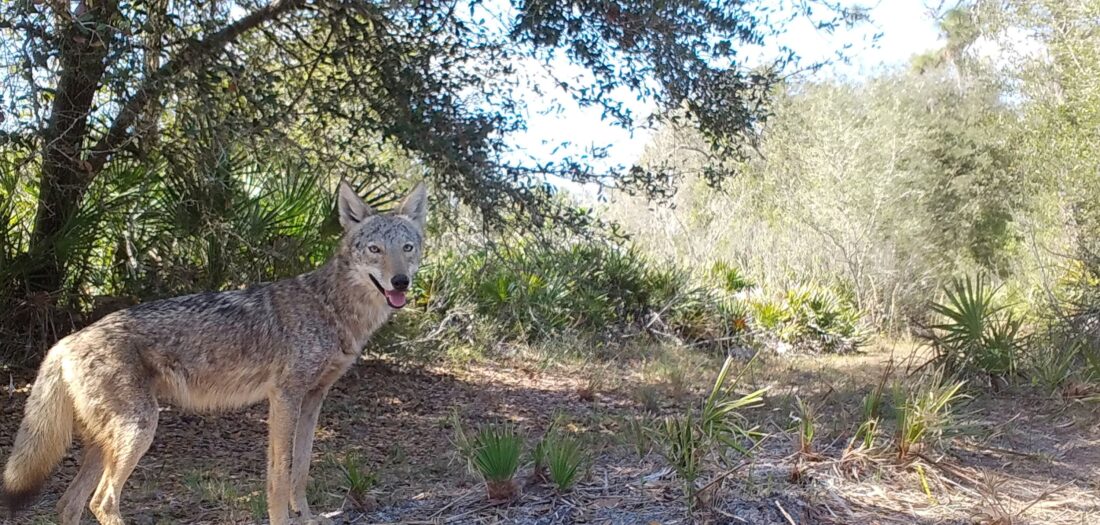Wildlife ecologist busts myths about coyote behavior, including their predatory actions
Whenever Hance Ellington gets a chance, he likes to talk about the science of coyotes, including their behavior around other animals. Dispelling coyote myths is a passion for Ellington, an assistant professor of wildlife ecology and conservation at the University of Florida.
“I enjoy studying coyotes because they are smart and adaptable animals that can live in many different places and show a plethora of behaviors,” said Ellington, a faculty member at the Range Cattle Research and Education Center, part of the UF Institute of Food and Agricultural Sciences. “They are also involved in many conflicts with people. Learning more about their behavior and ecology can help us find better ways to reduce these conflicts, which is one of the main goals of my research and Extension programs.”
He’s been studying coyote behavior since 2010. For his Ph.D. from Trent University in Ontario, Ellington studied coyote ecology and interactions with caribou in Newfoundland. During his postdoctoral work at The Ohio State University, he again examined them.
We asked Ellington to talk about why coyotes are important – to humans and other animals.
Q: How many coyotes live in Florida, and where are they found?
A: We don’t know how many coyotes are in the Sunshine State, but they are found almost everywhere. Some areas likely have more than others. Places with more food and fewer large predators — like Florida panthers or Burmese pythons in South Florida — can support more coyotes in more condensed areas.
Q: What should city and suburban residents know about coyotes?
A: Coyotes live in many suburban and urban areas of Florida. They naturally fear people and avoid them unless they get used to people and human food. In natural areas, coyotes eat a wide variety of things including, plant material (like fruits and nuts) and animals (like rodents, rabbits, reptiles, birds, and insects) – coyotes are also scavengers. In cities and suburbs, in addition to natural food sources, coyotes will also eat many
types of human-related food, including pet food, garbage and other food waste left outside. They can also prey on cats and small dogs, especially at night. Dogs should be kept on short leashes in areas where coyotes have been seen or in the more natural areas of cities, such as parks, wooded trails, etc. And keep cats indoors.
Q: How do we get the impression that coyotes sometimes attack people and pets?
A: While it has happened, coyote bites are extremely rare — about three per year in the United States and Canada. There have been only two recorded deaths from coyotes in the United States and Canada, compared to about 33 dog-related deaths every year in the United States alone.
When coyotes find a food source, they return to it, and repeated feeding can make them lose their fear of people. This increases the risk of bites, especially to toddlers and small children. Seeing more coyotes in an area can spark fears of attack, whether it is warranted or not. Aggressive coyotes should be reported to the Florida Fish and Wildlife Conservation Commission.
Q: How can understanding coyote foraging behavior help reduce conflicts?
A: Like people, coyotes make daily choices about where and when to look for food. We don’t fully understand what clues they use to decide — likely it’s based on how easy they think it will be to get certain food, but the details aren’t clear.
This lack of knowledge makes it hard to predict where and when they’ll be hunting or foraging in rangelands, forests or cities. Most human-coyote conflicts happen when coyotes are looking for food or hunting or around their den sites. If we can learn where and when those foraging and hunting behaviors occur, we can target prevention and control efforts more effectively and reduce conflicts.
Q: Do coyotes prey on calves and other livestock in Florida?
A: Ranchers sometimes report coyotes preying on calves, goats and sheep. While they can kill livestock, they also scavenge animals that have died from other causes, which may make predation seem more common than it is.
Two University of Florida studies tracked 711 newborn calves from birth to after weaning on five ranches in Collier, Hendry and other Southwest Florida counties. Neither found confirmed calf deaths caused by coyotes.
These results suggest that coyote attacks on calves are rare and not a major cause of losses for most Florida cattle ranches. However, it is possible that an individual coyote or coyote family could learn to prey on calves at a specific ranch. Coyotes are less likely to attack calves because they typically have many other food sources and because cows can and do defend their young, making calves a risky target.
Q: What are you studying about coyotes now, and what do you hope to learn?
A: We are studying coyote ecology — how they move, behave and use space in rangelands, forests and cities across Florida. We want to understand not just where and when coyotes behave in certain ways, but why they make those choices. For example, we are looking at how they choose travel routes — whether they follow natural cover, avoid busy roads or move toward areas with more food. This information can help predict where conflicts with people are most likely and guide strategies to reduce those conflicts while still allowing coyotes to play their role in the ecosystem. Coyotes are part of the Florida ecosystem and play an important role in nature by controlling rodent and rabbit populations, eating dead animals and spreading seeds from the fruit they eat.
ABOUT UF/IFAS
The mission of the University of Florida Institute of Food and Agricultural Sciences is to develop knowledge relevant to agricultural, human and natural resources and to make that knowledge available to sustain and enhance the quality of human life. With more than a dozen research facilities, 67 county Extension offices, and award-winning students and faculty in the UF College of Agricultural and Life Sciences, UF/IFAS brings science-based solutions to the state’s agricultural and natural resources industries, and all Florida residents. ifas.ufl.edu





